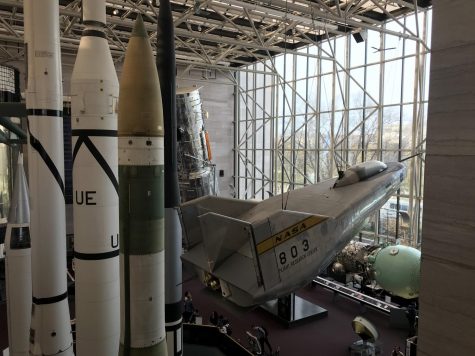NASA’s 2020 Perseverance Rover launches to Mars

The Smithsonian Air and Space Museum in D.C. has rovers, rockets and space capsules on display.
October 30, 2020
Expanding the frontiers of aerospace as we know it, the National Aeronautics and Space Administration (NASA) has developed a new surface-based venture into space that will expand the frontiers of aerospace as we know it. Launched in July, the Perseverance Rover will examine and analyze the geology and atmosphere of Mars while evaluating its past habitability capacity. The rover also will collect samples of rock and soil that could be returned to Earth in the near future in February 2021 for examination.
“I think it’s about time we sent another rover to Mars,” physics teacher Corey Porter said. “I think there’s so much promise when it comes to exploring Mars, not just from an interplanetary standpoint, but also from a biological, technological, engineering and social standpoint.”
This mission cost around $2.7 billion dollars and the rover is around 10 feet long and was a long-term project for the NASA scientists. The team worked to communicate long distances and used navigational tools to process large amounts of data. Through the use of several cameras and a microphone, the rover will send radio waves through its ultra-high frequency information back to Earth.
“I am thrilled to see that they’re to be looking for signs of life and studying the effects of the Martian environment on different materials,” Porter said.
According to NASA, the Perseverance Rover will find out how Earth and Mars originated from the same prehistoric material but ended up being so different. Additionally, the possibility of discovering life on Mars would provide many explanations for the unknown.
“I think it’s inevitable that we eventually send astronauts up there, and I think this is a necessary step in that direction that most people probably wouldn’t even consider,” Porter said. “I think there’s so much promise when it comes to exploring Mars, not just from an interplanetary standpoint, but also from a biological, technological, engineering and social standpoint.”
Mars is approximately 39.4 million miles away from Earth and the rover would take around seven months to reach the planet. Also, Mars’ radiation from the atmosphere is hazardous due to its low gravity and complete isolation. The Perseverance Rover has been put through a more challenging testing program than the journey to Mars and the environment it will face, thereby requiring the building of a state-of-the-art parachute attached to the rover and utilizing flame-resistant materials.
“I think that the Perseverance Rover represents humanity’s struggle to develop a more knowledgeable understanding of space,” senior and astronomy club president Tarun Anbumani said. “Its purpose is to seek life and collect data to further our knowledge about the terraform of different planets.”
According to NASA, this launch will begin another “historic mission of exploration” and will “make discoveries that will cause us to rethink our questions about what Mars was like and how we understand it today”.
The launch of the Perseverance Rover can be seen at:
https://mars.nasa.gov/mars2020/timeline/launch/watch-online



Porter • Nov 5, 2020 at 9:39 am
Awesome article, Rhea!